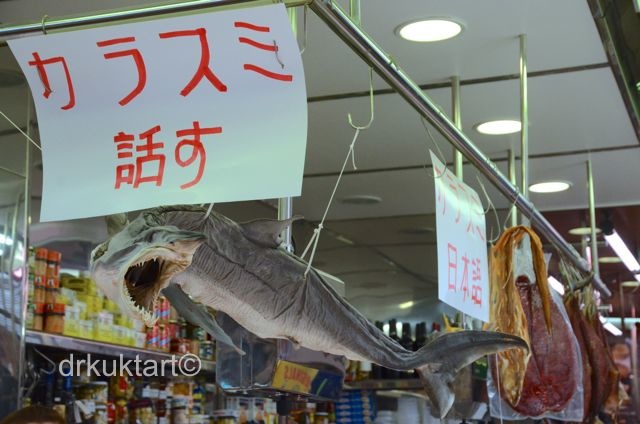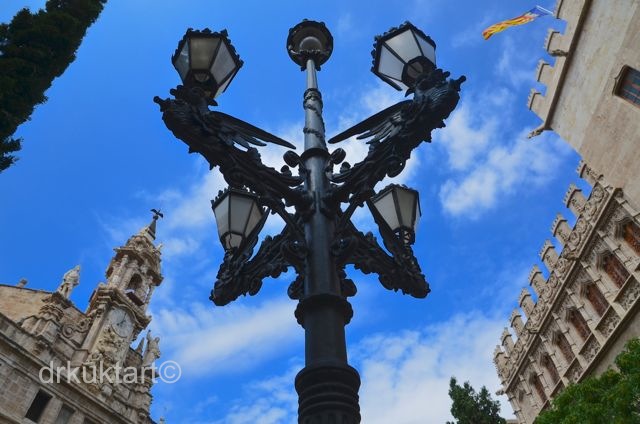
For English scroll down
Ha már annyira belejöttem a piaclátogatásba, gondoltam, ne csak Budapest vásárcsarnokaiba, de mondjuk Valencia központi vásárcsarnokába is belesek. Hozzám nem illően rövidke piaclátogatásra invitállak Titeket Valenciába!
I like to do shopping in the market. I have already visited more market halls in Budapest, so I thought I will make a tour in other countries' markets as well. Follow me and visit the Central Market of Valencia and its neighborhood.

A piac környezete is nagyon spanyol, persze milyen is lenne. A Központi Vásárcsarnok Valenciában házak közé zsúfolva található meg, nincs olyan szép rálátás az épületre, mint Budapesten a Nagycsarnokra. A fenti képen az 1482 és 1533 között épült gótikus La Lonja de la Seda látható, amely a selyem kereskedelem központja volt korábban, s amely szintén a csarnok környezetében található.
The neighborhood of the Central Market of Valencia is really crowded and full with buildings which were built really close to each other. You can see the building of La Lonja de la Seda on the picture above, which was the centre of silk trading (Silk Exchange). La Lonja de la Seda was built between 1482 and 1533 in Gothic style and it's located behind the market.

A csarnok tehát Valenciában, a Plaza del Mercado 6. szám alatt található.
The Central Market of Valencia is located on Plaza del Mercado 6.


Érdekesség, hogy Valencia turisztikai honlapja azt állítja, hogy a Valenciai Központi Csarnok Európa legnagyobb vásárcsarnoka a maga körülbelül 8.000 négyzetméterével, holott tudjuk, hogy a Budapesti Központi Vásárcsarnok területe körülbelül 10.000 négyzetméter.
It's a surprising fact for me that the tourism website of Valencia states that the Central Market of Valencia which is approximately 8.000 square metres, is the largest market of Europe, however we knew that the Central Market of Budapest which is approximately 10.000 square metres, is larger than the Central Market of Valencia.

Pozitív meglepetés, hogy a csarnoknak színvonalas többnyelvű honlapja van. A hivatalos honlap spanyol (két dialektus), angol, német, francia és holland nyelveken érhető el.
It's a positive surprise that the official website of the market is available on more languages: Spanish (two dialects), English, German, French and Dutch.

A csarnok jelenlegi helye - az épület felépülése előtt - az utcai piac színhelyéül szolgált. 1839-ben az úgynevezett Új Piac nyitotta meg itt kapuit, amely a Valenciai Központi Csarnok elődje volt, s amelyről már a XIX. század végén kiderült, hogy méretei okán nyilvánvalóan nem képes Valencia igényeit kiszolgálni. Több pályázati felhívás eredményeként a csarnok építését 1928-ban fejezték be, s ekkor át is adták a nyilvánosság részére.
According to its official website 'Ever since the initial expansion of the city, the area where the Mercat Central is currently situated was used as the regular location for a travelling street market. In 1839, the Mercado Nuevo was opened there, which was an outdoor market and the predecessor of the current Mercat Central. Towards the end of the 19th century, this market was clearly too small for the city of Valencia. (…)' The Town Council of Valencia issued more calls to tender bids for the construction of the new market. '(…) the market was built in accordance with the project dated November 1914. The architects Enrique Viedma and Ángel Romaní completed its construction in 1928. (…) Finally, on 23rd January 1928, the current building of the Mercat Central de Valencia was opened.'


A honlap elmondása szerint a csarnok Valencia egyik legkiemelkedőbb és leglátogatottabb épülete, amely tökéletesen illik a mellette elhelyezkedő La Lonja de la Seda (selyem tőzsde) és a Los Santis Juanes templom épületeihez. A piac kétségtelenül a korai XX. század Valenciájának leglátványosabb épülete, annak a Valenciának, amely a technikai és a kereskedelmi fejlődés útján töretlenül haladt előre, s amely büszke volt gazdasága mezőgazdasági potenciáljára. Ezt, a növekedés és a gazdasági termelés iránti elköteleződést a modernista felépítés és az allegórikus belső díszítés is híven tükrözi.
According to its website 'There is no doubt that the Mercat Central is a spectacular piece of architecture and one of the most attractive and visited buildings in Valencia. Its architecture matches the aesthetics of the square and blends perfectly with two other important monuments: La Lonja de la Seda (the silk exchange) and the Church of Los Santos Juanes. The Mercat Central is undoubtedly the most representative building of early 20th century Valencia, a city which was advancing towards technological and commercial progress and felt proud of the agricultural potential of its farmland. This commitment to progress and farming production can be seen in the modernist structure of the market and the allegorical decoration of its interior.'

A csarnok vas-üveg-kerámia kupolái (a középső kupola 30 méter magas) és a kupolák tetején található két (papagáj, illetve hal formájú) szélkakas szépen belesimulnak Valencia tornyokkal és harangtornyokkal tarkított tipikus sziluettjébe. A csarnokot eredetileg 959 árusító bódé számára tervezték, amely bódék - a kínált portékától függően - felül, illetve az alsó szinten voltak megtalálhatóak. A felső szinten található bódékban többek között hentesárut, fűszereket, vasárut, pékárut és sózott tengeri herkenytűket árultak, míg az alsóbb bódékban krumplit, hüvelyes növényeket, zöldséget, gyümölcsöt, baromfit és halat.
As you can read on its website: "The iron, glass and ceramic domes (the central one is 30 metres high) and the two weather vanes on top of them (in the shape of a parrot and a fish) blend into a typically Valencian skyline of towers and bell towers. "The interior layout of the market was designed along rationalist lines, with stalls placed along a number of straight aisles crossed by two wide thoroughfares. It was designed for 959 stalls, divided into upper and lower stalls depending on the products sold. The upper stalls were used for butchery, pork butchery, grocery, ironmongery, bakery, poultry, meat and game, salted fish and offal. The lower stalls sold potatoes, legumes, vegetables, fruit, hen and fish."





A csarnok hétfőtől szombatig reggel 7-től délután 3-ig tart nyitva.
Opening hours: from Monday until Saturday from 7.00 a.m. to 3.00 p.m.



Állítólag ez az első olyan csarnok a világon, amely a modern kor kihívásainak megfelelően 1996-ban bevezette a házhozszállítást, illetve az eladóhelyek majdnem mindegyike rendelkezik a bankkártyás fizetéshez szükséges terminálokkal. A házhozszállításról bővebb információt itt és itt találsz.
According to its website this is the first market in the world which computerized the sales and offers home delivery services since 1996. Nevertheless, POS terminals are available for payment by credit card at most of the market stalls. For more information about home delivery click here or here.


Furcsaság. Úgy tűnik mindegyik csarnoknak megvannak a sajátos díszítő elemei.
Strange sea 'something'. It seems that all market halls have their own decoration elements.

A fenti képen a Los Santis Juanes templom látható. A templom helyén az első templom 1240-ban épült, amelyet a XIV. és XVI. századokban, majd barokk stílusban a XVII. században is átépítettek.
You can see Church of Los Santis Juanes on the picture above. According to a website 'the first church was built in 1240 on the site of an old mosque. It was consequently modified in 14th and 16th centuries, with the baroque element appearing in 17th century'.



A csarnok mögött magasodik a Los Santis Juanes templom és a La Lonja de la Seda épülete.
The Church of Los Santis Juanes and La Lonja de la Seda are located behind the market.

Összegzésképpen elmondható, hogy a csarnok épülete csodaszép, és irigylésreméltó, hogy az elárusítóhelyek legtöbbjénél lehetőség van bankkártyás fizetésre. Ez utóbbinak, nem is beszélve a házhozszállításról, itthon is hasznát venném néha. Persze a házhozszállítás folyamatos igénybevételével többek között a piacra járás élményétől és a személyes kontaktustól fosztanám meg saját magamat, így a piacozás és az esetleges házhoz szállíttatás egészséges aránya mindenképpen megfontolandó és fenntartandó (lenne).
Ha érdekel a sorozat többi része is, elárulom, hogy Budapesten eddig a Fővám téri Nagycsarnokban (ITT), valamint a Rákóczi téri vásárcsarnokban jártam (ITT), a Klauzál téren található csarnokot pedig jól megkörnyékeztem (ITT).
Ha tetszett a bejegyzés, kövess Facebook-on ITT és Instagram-on ITT.
Szép napot kívánok!
The building of the market is beautiful and huge and I'm a bit envy of their home delivery services and the fact that you can pay by card almost at every stall. Nevertheless, I have to confess I would be happy to have the chance to try market home delivery services in Hungary as well. By using the home delivery service, I would divest myself of the experience of shopping in a real market and the human relationships, so it is worth to considering to use any similar service continually.
If you are interested in the other posts of my market-series then check the markets what I have already visited in Budapest: the Central Market Hall of Budapest HERE, the Market Hall on Rákóczi square HERE and the Market Hall on Klauzál square HERE.
If you like this post, follow me on Facebook HERE or Instagram HERE.
Have a nice day!
DRKUKTA



rexcramer 2014.07.07. 12:49:38
Köszönjük
Jöhet a többi!
csodatévő dzsagodar 2014.07.07. 21:30:58
drkuktart 2014.07.07. 21:33:31
Tycho.Brache 2014.07.08. 07:20:31
drkuktart 2014.07.08. 07:21:08